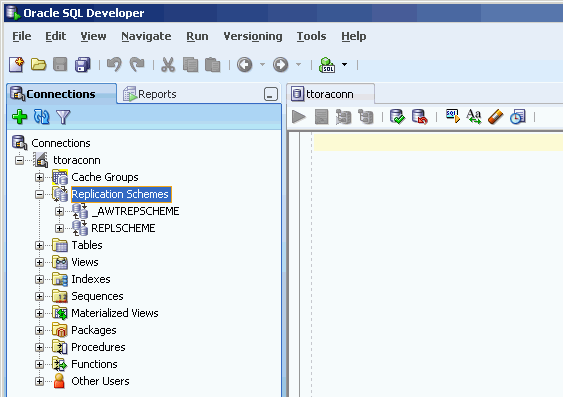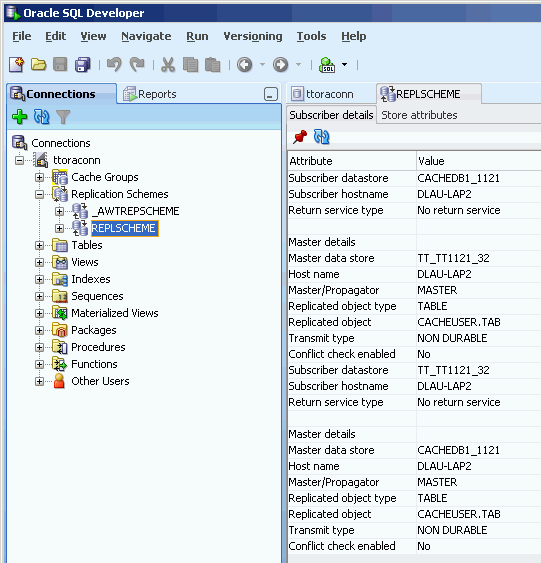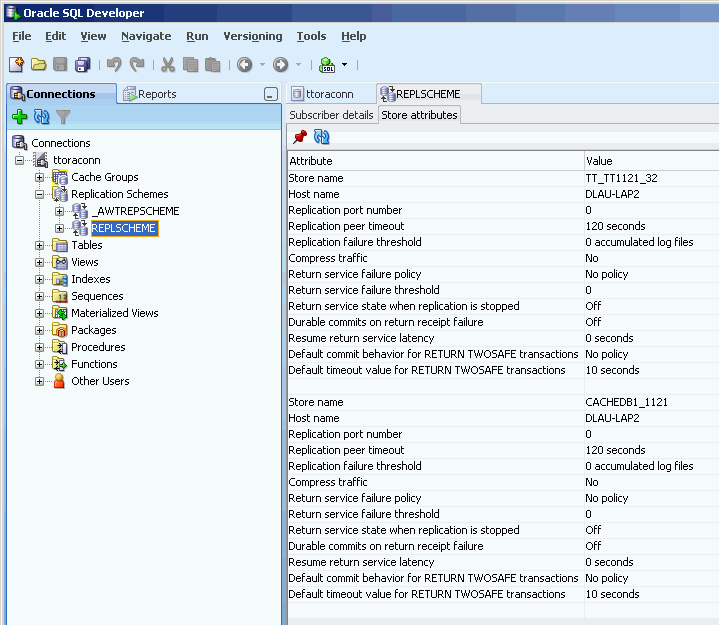6 Interfacing with TimesTen Replication
A replication scheme defines the set of elements that are replicated between two or more TimesTen databases when committed updates are issued on those elements. Replication can be configured at the table or database level in a unidirectional or bidirectional fashion with asynchronous or synchronous transmit.
View the characteristics of a replication scheme
To create a replication scheme, you need to manually compose and then execute a CREATE REPLICATION or CREATE ACTIVE STANDBY PAIR statement using a command-line interface such as the ttIsql utility, or within SQL Developer using SQL Worksheet. There is no graphical interface that allows you to select elements to replicate and specify replicated database attributes. After you have created a replication scheme, you can view the characteristics of the scheme itself such the database name and host name of the participating TimesTen databases, and its replicated elements.
Click the + to the left of the Replication Schemes node to view the list of replication schemes. Click the name of the replication scheme that you want to view the characteristics of.

The name of the replication scheme that is automatically created to propagate updates on cache tables in AWT cache groups to the corresponding Oracle tables is _AWTREPSCHEME.
The name of the replication scheme for an active standby pair is _ACTIVESTANDBY and it can be found under the Replication Schemes node of any existing database user.
If you are unable to find the replication scheme that you are looking for, see "Locate a TimesTen database element" for information.
View the details of the TimesTen subscriber databases
In the Subscriber details tab within the replication scheme's tab, it shows information such as the database name and host name of the master and subscriber TimesTen databases, the type and database name of the replicated elements, and the return service type.

View the store attributes of the replicated TimesTen databases
In the Store attributes tab within the replication scheme's tab, it shows information such as the TimesTen database name, host name, replication agent port number, replication response timeout period, and replication transaction log fail threshold for all databases participating in the replication scheme.
For replication schemes that have a return service defined, it also shows the return service failure policy, acknowledgement timeout period, and re-enable policy.

For more information about the creating a replication scheme, see "Defining Replication Schemes" in the Oracle TimesTen In-Memory Database TimesTen to TimesTen Replication Guide.
A replication scheme is automatically created when you create an AWT cache group. This replication scheme is owned by the TTREP user.
Start the replication agent
The replication agent process transmits committed updates on replicated tables in a master TimesTen database to replicated tables in a corresponding subscriber TimesTen database. The replication agent is also responsible for asynchronously propagating committed updates on TimesTen cache tables in AWT cache groups to its corresponding Oracle tables. After you create a replication scheme or an AWT cache group, you need to start the replication agent if it is not already running.
To start the replication agent, right-click the node that contains the name of your database connection and select Start/Stop Replication Agent.

In the Starting/stopping the replication agent dialog box, put a check in the Start agent check box within the Prompts tab. Then click the Apply button to start the replication agent.

The replication agent will not start if there are no replication schemes or AWT cache groups in the TimesTen database that you are connected to.
To stop a running replication agent process, right-click the node that contains the name of your database connection and select Start/Stop Replication Agent in an identical fashion as was done when starting the replication agent.
In the Starting/stopping the replication agent dialog box, put a check in the Stop agent check box within the Prompts tab. Then click the Apply button to stop the replication agent.

For more information about the replication agent process, see "Starting and stopping the replication agents" in the Oracle TimesTen In-Memory Database TimesTen to TimesTen Replication Guide, "Managing the replication agent" in the Oracle In-Memory Database Cache User's Guide, or "Starting the replication agent for an AWT cache group" in the TimesTen Cache Connect to Oracle Guide.